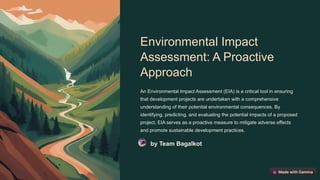
Report on Environment impact assessment.
- 1. Environmental Impact Assessment: A Proactive Approach An Environmental Impact Assessment (EIA) is a critical tool in ensuring that development projects are undertaken with a comprehensive understanding of their potential environmental consequences. By identifying, predicting, and evaluating the potential impacts of a proposed project, EIA serves as a proactive measure to mitigate adverse effects and promote sustainable development practices. by Team Bagalkot
- 2. Historical Roots and Evolution 1 National Environmental Policy Act (1969) The United States enacted the National Environmental Policy Act (NEPA) in 1969, marking a pivotal moment in the history of EIA. This groundbreaking legislation mandated the evaluation of environmental impacts for federal projects, setting a precedent for other nations to follow. 2 Early Adoption in India (1976-1977) India's embrace of EIA began in the late 1970s when the Planning Commission directed the Department of Science and Technology to assess river valley projects from an environmental perspective. This initial step paved the way for broader implementation across various sectors. 3 EIA Notification (1994) In 1994, the Ministry of Environment and Forests, under the Environmental Protection Act of 1986, promulgated the EIA Notification. This landmark regulation made EIA mandatory for certain development projects, ensuring a comprehensive evaluation of their potential environmental impacts.
- 3. Types of Environmental Impact Assessments Rapid Environmental Impact Assessment Rapid EIA is conducted for projects that are likely to cause limited adverse impacts. It involves data collection for a single season (except monsoon), providing a relatively shorter time frame of approximately three months. This type of assessment is suitable for projects with anticipated minor environmental implications. Comprehensive Environmental Impact Assessment Comprehensive EIA is a more extensive process, typically conducted over the course of a year, involving data collection across three seasons (excluding monsoon). This thorough assessment is necessitated for projects anticipated to have significant or multiple adverse impacts, ensuring a comprehensive understanding of potential environmental consequences.
- 4. Purpose and Objectives of EIA 1 Identification and Assessment EIA serves to identify, estimate, and assess the critical effects that a proposed project may have on the environment. This proactive approach ensures that potential impacts are thoroughly evaluated before project approval. 2 Informed Decision-Making By presenting comprehensive data on potential impacts, EIA reports equip authorities responsible for project approval with the necessary information to make informed decisions, considering both environmental and developmental factors. 3 Environmental Protection EIA encourages authorities to incorporate ecological considerations into their decision-making process, safeguarding valuable natural resources, ecosystems, and promoting sustainable development practices. 4 Procedural Standardization EIA fosters the creation of standardized procedures for information exchange, reporting, and consultation among stakeholders, ensuring transparency and collaboration throughout the assessment process.
- 5. The EIA Process: A Comprehensive Approach Screening The initial step in the EIA process involves screening the proposed project to determine whether a full or partial impact assessment is required, based on the nature, location, and potential environmental implications of the project. Scoping Once the need for an EIA is established, the scoping phase identifies the key issues and potential impacts that should be addressed in the assessment. This step involves consultation with relevant stakeholders, including local communities and environmental experts. Baseline Data Collection Comprehensive baseline data is collected to establish the existing environmental conditions in the project area. This data serves as a reference point against which potential impacts can be measured and monitored. Impact Prediction and Evaluation Using scientific methods and modeling techniques, the potential impacts of the proposed project are predicted and evaluated. This step considers both direct and indirect impacts, as well as cumulative effects resulting from other development activities in the area. Mitigation and Management
- 6. Advantages and Benefits of EIA Informed Decision-Making EIA provides decision-makers with comprehensive information on the potential environmental impacts of a proposed project, enabling them to make informed choices that balance development goals with environmental considerations. Reduced Environmental Damage By identifying potential impacts and proposing mitigation measures, EIA helps minimize or avoid environmental damage, protecting natural resources, ecosystems, and promoting sustainable development practices. Cost Savings Conducting an EIA early in the project planning stage can help identify and address potential issues, reducing the need for costly design changes or remediation efforts later in the project lifecycle. Increased Project Acceptance The transparent and participatory nature of the EIA process, which involves stakeholder consultation and public engagement, can increase project acceptance and reduce potential conflicts or legal challenges.
- 7. Challenges and Limitations of EIA Uncertainty and Subjectivity The accuracy of impact predictions and assessments can be influenced by uncertainties, assumptions, and the subjective interpretations of experts involved in the EIA process. Time and Resource Constraints Conducting a comprehensive EIA can be time- consuming and resource-intensive, potentially delaying project timelines and increasing costs, especially for large- scale or complex projects. Expertise and Capacity Limitations Ensuring the availability of qualified and experienced experts in various environmental domains can be a challenge, particularly in regions with limited resources or specialized training programs. Inadequate Follow-up and Monitoring In some cases, the implementation and monitoring of mitigation measures and environmental management plans may be lacking, undermining the effectiveness of the EIA process.
- 8. Conclusion: Balancing Development and Environmental Protection Environmental Impact Assessment serves as a crucial tool in striking a balance between economic development and environmental protection. By proactively identifying and mitigating potential impacts, EIA promotes sustainable development practices and informed decision-making. While challenges exist, continual improvements in methodologies, stakeholder engagement, and regulatory frameworks can further enhance the effectiveness of EIA in safeguarding our natural resources for future generations. As we navigate the complexities of development and progress, EIA plays a vital role in ensuring that our pursuit of economic growth does not come at the cost of irreversible environmental damage. By embracing a comprehensive and holistic approach to impact assessment, we can pave the way for responsible and sustainable development that meets the needs of the present without compromising the ability of future generations to meet their own needs.